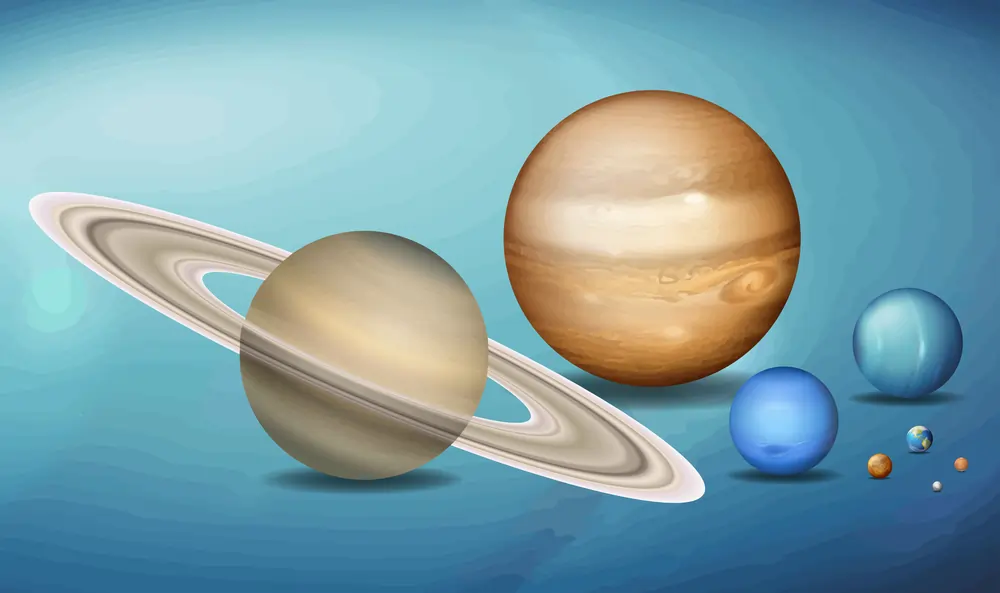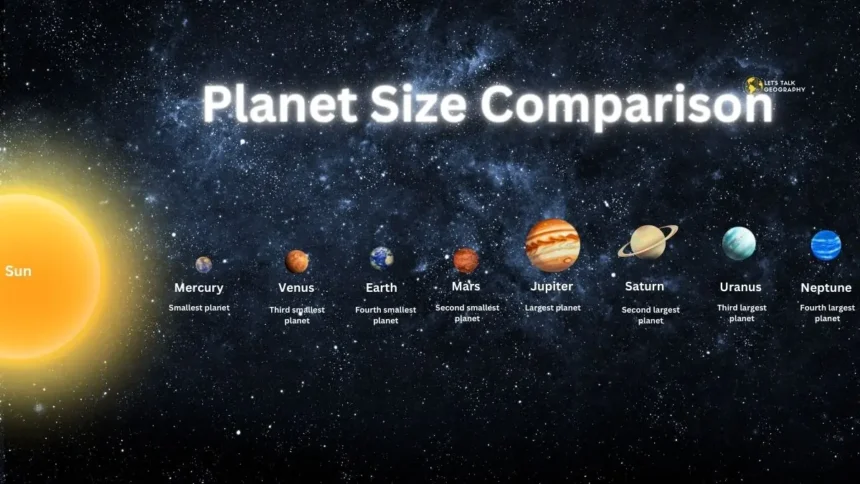Introduction
Have you ever wondered how the planets in our solar system measure up against each other? The vast differences in size between these celestial bodies are truly awe-inspiring. In this article, we will embark on a fascinating journey through a planet-size comparison, examining the staggering scale of these distant worlds.
Understanding the planet size comparison highlights the diversity within our solar system and provides insights into their unique characteristics and formation processes. From the enormous gas giants like Jupiter to the smaller rocky planets like Mercury, this planet size comparison will reveal the wonders of our cosmic neighborhood.
Join us as we explore the planets’ incredible dimensions and gain a deeper appreciation for the complexity and beauty of our universe.
Read also: How many solar systems are in the milky way galaxy
Read also: 3 Most Important Theories to Explain How the Solar System Formed?
Types of Planets in the Solar System
Planets in the solar system are generally classified into two groups based on some criteria: i) Inner Planets and ii) Outer Planets.
Inner Planets (Terrestrial Planets)
Terrestrial planets are defined as planets composed mainly of silicate, rocks, and metals. They are accepted as the IAU, closest to the Sun, inside the solar system. Terrestrial planets primarily have solid planetary surfaces, making them look larger than gaseous planets, which consist of hydrogen, helium, and water.
Mercury
- Mercury, the nearest to the Sun and the smallest in size and mass is the most elusive of the planets visible to the naked eye.
- Its proximity to the Sun and its diminutive size make it difficult to observe.
- Mercury always rises or sets within about two hours of the Sun, making it impossible to see when the sky is dark.
- Mercury’s diameter is 3,030 miles (4,878 km), roughly similar to the size of the continental United States, making it about two-fifths the size of Earth.
- In planet size comparison, Mercury is smaller than Jupiter’s moon Ganymede and Saturn’s moon Titan. With a mean radius of 1,516 miles (2,440 km), Mercury’s equatorial circumference measures 9,525 miles (15,329 km).
Venus
- Venus, the second planet closest to the Sun and the sixth largest in planet size comparison, is the closest neighboring planet to Earth within our solar system.
- At its nearest approach, Venus is the closest large body to Earth, aside from the Moon.
- Due to its orbit being nearer to the Sun than Earth’s, Venus always appears roughly in the same direction as the Sun in the sky. Consequently, it can only be observed during the hours near sunrise or sunset.
- Venus is part of the Milky Way galaxy, and its unique positioning and visibility highlight the fascinating dynamics of our solar system. Its diameter is about 7521 miles or 12104 kilometers.
- Venus revolves around the Sun at an average distance of 108 million kilometers (67 million miles), approximately 0.7 times the distance between Earth and the Sun. Within our solar system, this orbit places Venus closer to the Sun than Earth.
Earth
- In a planet size comparison, Earth is the third planet closest to the Sun and the fifth biggest in our solar system.
- In a planet size comparison, Earth’s equatorial circumference is 24,901 miles (40,075 kilometers), and its diameter is 7,926 miles (12,756 kilometers).
- Earth revolves around the sun at a speed of 67000 miles per hour and rotates at about 1000 miles per hour, 1600 km/hr.
Read also: How Many Earths Can Fit in the Sun?
Mars
- In a planet size comparison, Mars is the fourth planet in the solar system regarding distance from the Sun and ranks seventh in size and mass.
- Mars is periodically visible as an Earth-size planet as a conspicuous reddish object in the night sky, earning it the nickname “Red Planet.” This reddish-orange hue is due to the abundance of iron minerals and dust on its surface.
- Compared to Jupiter, the most giant planet in the solar system, Mars is significantly more minor but still holds a prominent place in our cosmic neighborhood.
- In a planet size comparison, Mars revolves around the Sun at a mean distance of 228 million kilometers (140 million miles), which is about 1.5 times the spacing of Earth from the Sun.
- Mars is an Earth-size planet. Its orbit places it farther from the Sun than Earth, making it smaller than Jupiter, the solar system’s most giant planet.
Read also: What is the Order of the Planets in the Solar System?

Outer Planets (Gas Giants and Ice Giants)
The four planets farthest from the Sun are called the outer planets. These are the solar system giants primarily made of liquid and gas. The outer planets are classified into two types – i) gas giants & ii) ice giants.
Gas giants are defined as massive planets mainly consisting of helium and hydrogen.
Ice giants may be defined as the giants of planets in our solar system, composed of oxygen, nitrogen, uranium, and Neptune.
Jupiter
- In a planet size comparison, Jupiter is the biggest planet in the solar system and the fifth in distance from the Sun.
- As the most giant planet in the solar system, it is one of the illuminating objects in the night sky, outshone only by the Moon, Venus, and occasionally Mars.
- Unlike Earth-size planets, Jupiter has an internal heat source, emitting more energy than it receives from the Sun.
- The immense pressure in its deep interior causes hydrogen to exist in a fluid metallic state.
- Jupiter boasts an equatorial range of about 143,000 km (88,900 miles) and revolves around the Sun at a mean spacing of 778 million km (483 million miles).
- Within the vast Milky Way galaxy and neighboring galaxies, Jupiter’s colossal size and unique characteristics make it a remarkable giant in our cosmic neighborhood.
Saturn
- Because of its mass and size, Saturn, in planet size comparison, is the second-largest planet in the solar system and the sixth closest planet to the Sun.
- Within the Milky Way galaxy, Saturn orbits the Sun at an average distance of 1,427,000,000 km (887 million miles).
- When closest to Earth, Saturn is approximately 1.2 billion km (746 million miles) away. This immense distance underscores the vastness of our galaxy and the intriguing dynamics between planets within the Milky Way and in neighboring galaxies.
Uranus
- In planet size comparison, Uranus, the seventh planet, is the least massive of the solar system’s four giant planets, which include Jupiter, Saturn, and Neptune.
- Situated within the Milky Way galaxy, Uranus orbits the Sun at a mean distance of nearly 2.9 billion km (1.8 billion miles), over 19 times farther than Earth’s distance from the Sun.
- It never comes closer to Earth than about 2.7 billion km (1.7 billion miles), highlighting the vast distances between celestial bodies within our galaxy.
Read also: When will the Andromeda and Milky Way Galaxy Collide
Neptune
- In planet size comparison, Neptune is the third-biggest planet in the solar system and the eighth-and-outermost from the Sun.
- It is situated in the Milky Way galaxy, and due to its great distance from Earth, it is not visible to the unaided eye.
- It is nearly four times the size of Earth yet slightly smaller in diameter than Uranus, making it the smallest of the four giant, or Jovian, planets.
Read also: Andromeda Galaxy: definition, Facts, distance, location
Read also: Different Types of Galaxies in the Universe
Factors contributing to the Planet Size Comparison
When the Solar System was forming, differences in the density and composition of the Cloud of Dust and Gas plus position from the central area of the cloud where the Proto-Star (The Sun) was forming caused variations in the sizes of the planets. Some planets attracted more solid objects; others attracted more gas as the area around them was rich in gases due to being further away from the emerging Sun, thus making the gas giants.
At the preliminary level, the size of the planets is calculated by the ratio of dust to gas present during the formation time. The more dust, the greater the likelihood of small rocky planets. The factors include-
- The nearer the planets or the protoplanets are to their star, the more opportunity there is for its gas envelope.
- There tends to be a host of protoplanets that engage with time until the place is full of dust and gases.
Read also: Exploring exoplanets: a journey towards the Distant Worlds
Conclusion
In conclusion, understanding the vast differences in planetary sizes within our solar system offers a fascinating glimpse into the diverse characteristics that make each planet unique. From the enormous size of Jupiter, the largest planet, to the comparatively small Mercury, each celestial body plays a crucial role in the cosmic tapestry. This planet size comparison highlights the immense scale and variety and underscores the intricate dynamics that govern our solar system.
By exploring these size disparities, we gain a deeper appreciation for the complexities and wonders of our celestial neighborhood. This knowledge enhances our understanding of planetary formation, composition, and the broader workings of the universe. Engaging in a planet-size comparison enriches our perspective, inspiring curiosity and awe about the mysteries beyond our world.
FAQs
1. What is the largest planet in our solar system?
Jupiter is the largest planet in our solar system, with a diameter roughly 11 times that of Earth.
2. How does Earth compare in size to other planets?
Earth is the fifth-largest planet in our solar system, bigger than Mercury, Mars, and Venus but significantly smaller than the gas giants.
3. Is there a planet larger than the Sun?
No, the Sun is a star, far larger than any planet in our solar system or any exoplanets discovered so far.
4. What is the smallest planet in our solar system?
Mercury is the smallest planet in our solar system, even smaller than some of the moons of other planets.
5. How is planet size measured?
Planet size is typically measured by diameter, the distance across the planet at its widest point.
6. Are there planets larger than Earth outside of our solar system?
Yes, many exoplanets (planets outside our solar system) have been discovered that are much larger than Earth, some even categorized as “super-Earths” or “mini-Neptunes.”
References
- Chapman, C. R. (2024). Mercury. In Encyclopedia Britannica.
- Tillman, N. T. (2016, August 31). How big is mercury? Space.com; Space. https://www.space.com/18647-how-big-is-mercury.html
- Squyres, S. W. (2024). Venus. In Encyclopedia Britannica.
- Lunine, J. I., Chapman, C. R., & Jeanloz, R. (2024). Earth. In Encyclopedia Britannica.
- How large is Earth? (n.d.). Cool Cosmos. Retrieved May 23, 2024, from https://coolcosmos.ipac.caltech.edu/ask/57-How-large-is-Earth-
- Carr, M. H., Malin, M. C., & Belton, M. J. S. (2024). Mars. In Encyclopedia Britannica.
- Owen, T. C. (2024). Jupiter. In Encyclopedia Britannica.
- Marley, M., Hubbard, W. B., & Buratti, B. (2024). Saturn. In Encyclopedia Britannica.
- Ingersoll, A. P. (2024). Uranus. In Encyclopedia Britannica.
- Miner, E. D. (2024). Neptune. In Encyclopedia Britannica.

